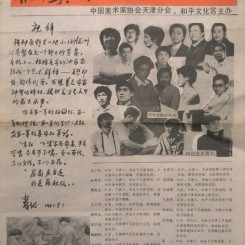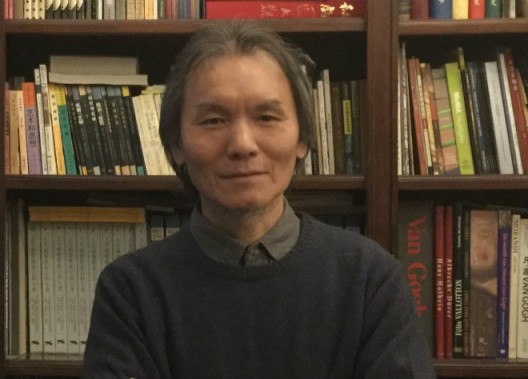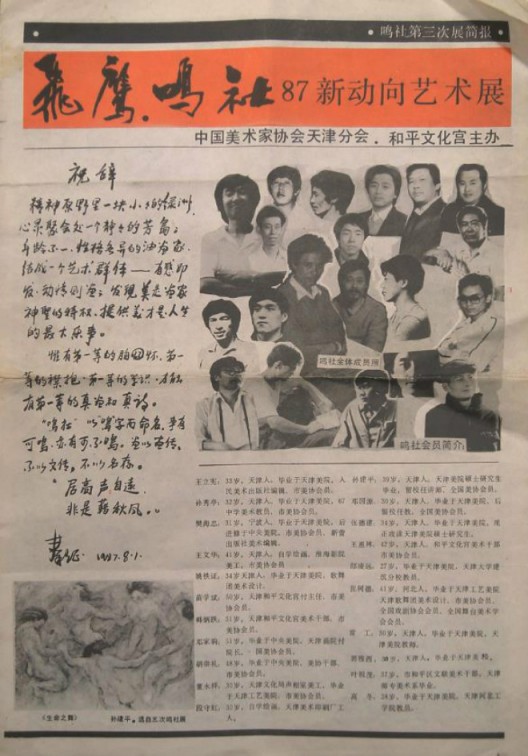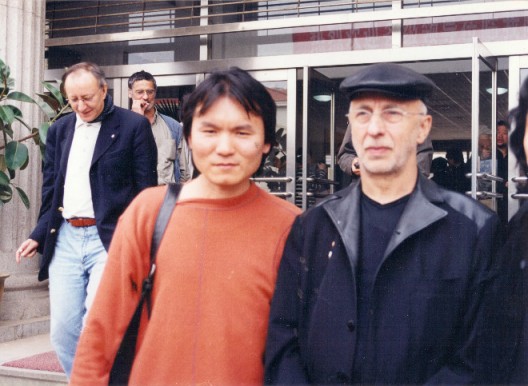Tianjin, just half an hour by train from Beijing, is said to be the most inconspicuous of China’s municipalities. This is perhaps surprising, given the fact that it is the first city in Northern China to be exposed to modern culture, experiencing a glamorous era in the period following 1860 when it became a treaty port. Tianjin is the epitome of modernity with “Chinese characteristics”. Likewise, its modern/contemporary art has been reticently uncooperative in style since the 1980s, retaining its own sensibility distinct from Beijing’s radical avant-garde movements. We talked to Guo Yaxi, a Professor at Tianjin Academy of Fine Arts, who was a member of “Ming Society”, the first avant-garde art group in Tianjin, and an important art critic of the so called “Experimental Ink Art” movement.
Professor Guo Yaxi, 2020
Maybe we can start by talking about the avant-garde movement in Tianjin, could you describe it according to your personal experience?
I actually majored in design as an undergraduate, and I worked in packaging design after finishing school. But my real interests have always being painting and reading. I spent my spare time either in the library or painting. But at that time, my reading and painting were kind of spontaneous, neither targeted nor systematic. It was in the early 1980s, especially during the so called “1985 New Wave” cultural movement, that there appeared a passion among those in the academic circles for translating classic Western philosophy books, including Jean-Paul Sartre’s “Being and Nothingness”. In hindsight, such books exerted great influence on Chinese art and literature. In 1985, I joined the first avant-garde movement in Tianjin, the “Ming Society” (Ming She) and began to write articles discussing the concerns of Ming Society under the pseudonym “Si Ming”. I remember that at the third Ming Society painting exhibition in 1987, our painting society received some sponsorship. I published an article titled “Ming Society, Child of our Time” in the Ming Society newspaper, which generated some attention from the art world at that time. Indeed, “Ming Society” in Tianjin, together with the “Chi Society” in Hangzhou, the “105 Painting Association” in Guangzhou, “Shen Society” in Yunnan, and the “Northern Artist Group” in Changchun can all be considered as embodying the new ethos of the 1980s.
“Ming Society” Newspaper, 1987
You are recognized as a pioneer scholar of the so called “Experimental Ink Painting” movement. For more than three decades, you have been studying the modernization of Chinese ink painting. Can you talk about the new trends and changes within the field of ink painting that have occurred throughout the last 30 years?
I got involved in the “Experimental Ink Painting” school early on. I started working on my master’s degree in 1991 at Tianjin Academy of Fine Arts, and in 1994 I began my teaching career there. I have always paid close attention to issues of the relationship between contemporary Chinese art and Western modernism. Since being admitted to graduate school, I gradually gave up painting and began to focus more on theoretical research. From 1994, I began to publish articles in for example, the series “New Trends of Modern Chinese Ink Art at the End of the 20th Century” edited by Zhang Yu, and the “Contemporary Art” series edited by Zou Jianping.
As the contemporary art world’s interest in experimental ink art has grown, my articles are also receiving increased attention. For example, my article “Report on the Development of Experimental Ink Painting” from 2004 is often reprinted and cited as the first systematic investigation of this topic.
From the late 1990s to the 21st century, in addition to writing some papers and publishing several monographs, I curated and co-organized some experimental exhibitions, not necessarily confined to experimental ink painting, such as “Being and Expression” (exhibition and symposium, 1999), “Dialogue 1999″ (1999), “An Exhibition of Graphic Arts of the Neo-Expressionist Master Jörg Immendorff” (2002), “Experimental Architecture: People, Ethics, Space” (2002), “Qualitative: Report on Experimental Ink and Wash Painting” (2005), as well as the international symposium “The Writing of History of Contemporary Art” (Tianjin Academy of Fine Arts, 2011, co-organized with Prof. Gao Minglu and Prof. Zhou Yan).
If I had to generalize about the development of Chinese contemporary art, based on my observations and practice since the 1980s, I would say that the 1980s saw more imitation of Western artistic counterparts, while the awakening of the Chinese local experience was marked by the emergence of “experimental ink” practices in the 1990s; and then heading into the 21st century, we have seen a tendency of Chinese contemporary art to go beyond geographic borders, and achieve further integration into world art institutions.
With the Neo-Expressionist Master Jörg Immendorff, 2002
Your endeavors are not just limited to experimental ink art, you co-authored, along with your students, the first monograph on the history of oil painting in Tianjin. Based on your research, what are the particularities of the development of oil painting in this city? What sparked your interest in writing this book?
It was all for the purpose of “pure art”—an idea that can be traced back to the time of Édouard Manet in the 1860s—that I joined Ming Society in the 1980s, decided to start a career as an art history teacher, and then, wrote this book “Literature on Tianjin Oil Painting” (Tianjin University Press, 2007) with the assistance of some of my graduate students. As one of the earliest cities open to the outside world in the early 20th century, Tianjin has a very distinct oil painting tradition, which is different from the more subject-oriented oil painting in Beijing, and different from Shanghai’s more technically refined styles. Rather, through the book, one can detect a shift in focus in the development of oil painting in Tianjin from formalist to expressionist aesthetics. Although Tianjin oil painting is a regional rubric, it is not unrelated to world modern culture.
At “Ming Society · Nude Art Exhibition”, 1988
Your monograph “Case and History: Chinese Contemporary Art Related to Tianjin” published by Peking University Press is your theoretical analysis of the contemporary art movements in Tianjin. Taking the Tianjin phenomenon here in your book as a case study, what kind of insights can it provide in relation to the understanding and writing of Chinese contemporary art histories?
Well, you can understand “Case and History” as an extension of my research in “Literature on Tianjin Oil Painting”. In the earlier book, the focus is more on the modern period and the autonomy of art, while in “Case and History”, I focused more on the relationship between postmodern culture and contemporary art in Tianjin. Since the 1980s, many well-known artists have emerged in Tianjin. These artists are not just important members of the Chinese contemporary art community, but more importantly, the example of Tianjin contemporary art epitomizes the cultural encounters between the East and the West. In 2012, I was invited to give a lecture at Kenyon College, Ohio. My translator was a student there, Mark Bosse, who had just won a Fullbright scholarship with his research project “Beyond Shanghai: The Alternative Modernity of Treaty Port Tianjin”. He chose Tianjin instead of Shanghai as his case study to further explore the recent history of China. In fact from the perspective of art, when it comes to Tianjin and China, and Tianjin and the world, there are many more valuable topics that have yet to be explored.
Interviewer: Liang Shuhan





